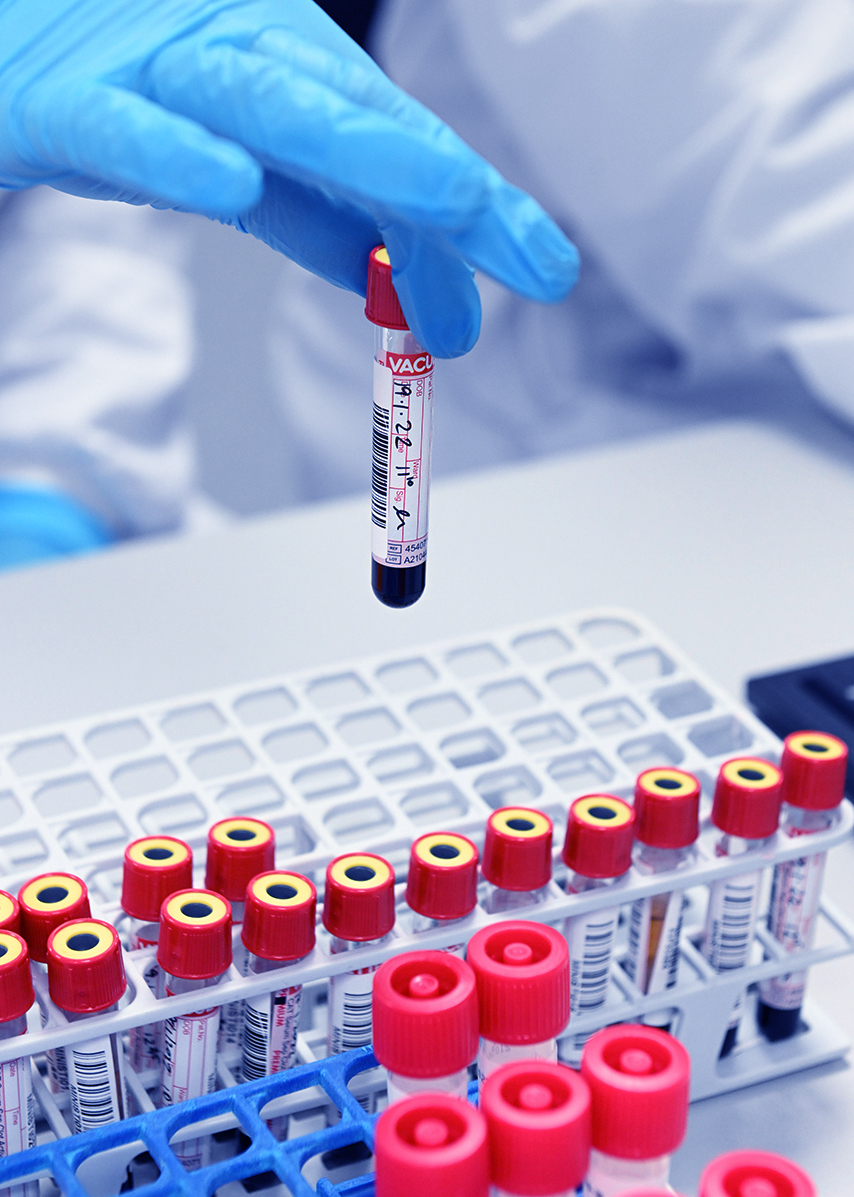An FBC incorporates several parameters including the quantities of platelets, white and red blood cells, as well as haemoglobin concentration and the haematocrit level – the volume of RBC to plasma. It also calculates red blood cell indices (MCV, MCH and MCHC) the size of red blood cells and their haemoglobin content are evaluated along with RDW which measures how varied the RBCs are in size and volume; and a white blood cell differential.
Full Blood Count

Full Blood Count
The Full Blood Count (FBC) is one of the most commonly requested tests and is used to investigate, diagnose and monitor a range of conditions.
Overview of haemoglobin, haematocrit, RBC indices
An increased number of RBCs causes haemoglobin and haematocrit to increase, and once dehydration and diuretic therapy are excluded, may indicate polycythaemia. Polycythaemia can be due to overproduction of RBCs or a loss of plasma volume causing an overall concentration in the volume of RBCs.
An abnormally low haemoglobin, haematocrit or RBC count indicates anaemia. Evaluation of red blood cell indices is helpful in determining the cause. Anaemia can be caused by defective RBCs, decreased production of RBCs, increased loss, or destruction. MCV is useful in classifying it as normocytic, microcytic or macrocytic. The most common cause of microcytic anaemia is iron deficiency. The absence of iron remains the definite test for differentiating iron deficiency from other microcytic states, such as anaemia of chronic disease, thalassaemia and sideroblastic anaemia.
Normocytic anaemia can occur after acute blood loss, with anaemia of chronic disease, haemolytic anaemia, hypothyroidism, bone marrow failure, renal failure, aplastic anaemias or pregnancy.
Mixed anaemias can develop in conditions where absorption from the gut is impaired such as coeliac disease leading to both iron (microcytic) and vitamin B12 (macrocytic anaemia).
Macrocytic anaemia is mainly due to alcoholism, vitamin B12 and folate deficiency, blood disorders (aplastic anaemia, myelodysplastic syndromes, myeloid leukaemia or medication induced).
Haematocrit is determined by the number of RBC and volume of plasma, a raised Hct can result in increased blood viscosity. Severe increases can induce hyperviscosity syndrome causing thrombus formation.
WBC differential
An elevated WCC count, leukocytosis, can have several underlying factors, the most common being infection, inflammatory response, post surgery, burns or trauma, or as a result of steroid use. Acute leukaemias can also present with an acute elevation. Chronically elevated WCC can occur with long standing infection, smoking or pregnancy, or due to myeloproliferative and lymphoproliferative disorders.
Low levels of WCC, leukopaenia, have many underlying causes which depend on the rate of reduction and type of WBC count involved. Infection, medication (chemotherapy, immunosuppressants, anti epileptics), B12, folate or iron deficiency, autoimmune disease or HIV.
Neutrophils account for 40 – 60% of total white blood cells. Neutrophilia most commonly occurs as a result of bacterial infection, inflammation, myeloproliferative disorders or steroid use. Neutropaenia occurs when neutrophils drop below < 1.5 x 10/L. Febrile neutropaenia in the setting of infection warrants in hospital assessment and IV antibiotic treatment.
Lymphocytes account for 20 – 40% of total WBCs in the blood. High levels typically occur as a result of acute viral infections, however sometimes it may be due to underlying malignancy, lymphoma or lymphoproliferative disorder such as CLL. Low levels occur and are usually transient, occurring with steroid use, SLE, uraemia, HIV infection, immunosuppressants, renal failure and bone marrow disorders.
Monocytes account for approximately 5% of total WBCs in the blood and are associated with immune response, increasing with chronic infection like TB, malaria, brucellosis, malignancy (AML & Hodgkins disease), steroid use or post chemo/radiotherapy.
Eosinophils account for approximately 2% of total WBCs, increased levels are most commonly associated with allergy/atopy, parasitic infections, vasculitis or malignancy.
Basophils account for 1% of total WBCs and like eosinophils, have a role in allergic, atopic, asthmatic conditions or IgE mediated hypersensitivity reactions and parasitic infections. An increased number of basophils, termed basophilia, can occur in myeloproliferative disorders like chronic myeloid leukemia and polycythemia vera.
Blasts are immature cells found in the bone marrow. A release of these premature cells from the bone marrow is abnormal indicating haematological malignancy such as leukaemia or myeloproliferative disorders.
Platelets
Thrombocytopaenia, or low platelet count, occurs as a result of infection or bleeding, acute viral infection, medications such as immunosuppressants, antiepileptics, cytotoxic agents, due to DIC, HIT or ITP or in preeclamptic mothers with HELLP syndrome.
Chronically low counts occur as a result of liver cirrhosis, hypersplenism, excess alcohol intake, medications, ITP, B12/folate deficiency, HIV, hepatitis B/C, bone marrow failure.
A raised count is known as thrombocytosis and can be due to infection, inflammation, after blood loss, iron deficiency states, post splenectomy, myeloproliferative disorders.
Case Study
Delivering True Innovation
Our Services




5mL Whole blood EDTA
Enfer Medical
Tests/Assays
Enfer Medical offers a Full Blood Count analysis, for the quantitative determination, identification, and existence ration of tangible components of whole blood by means of electrical impedance, laser light scattering, and dye bonding.


| • Red Cell count |
| • Haemaglobin |
| • Haematocrit |
| • Mean Cell Volume |
| • Mean Cell Haemaglobin |
| • Mean Cell Haemaglobin Concentration |
| • Red Cell Distribution width (SD) |
| • Red Cell Distribution width (CV) |
| • Platelet count |
| • Reticulocyte counts |
| • White Cell count |
| • Neutrophil count |
| • Lymphocyte count |
| • Monocyte count |
| • Basophil count |
| • Eosinophil count |
Patient
Request Form
For clients using the Enfer Medical Client Portal, the Enfer Medical Patient Request Form (PRF) will be generated when you have completed your “Test Request” within the portal linked below.
Please note that samples suspected of containing high risk pathogens such as Mycobacterium tuberculosis should be clearly identified on the form and packed separately from other samples.



Results are available next working day.
This assay is available seven days a week.
Packaging
The packaging/preparation of samples for delivery to the laboratory are required to be in adherence to all national regulations for the safe transport of biological materials. HSE guidance can be reviewed HERE.
There are specific packaging instructions and labelling requirements requiring triple packaging including:
- Primary leak-proof container – tube or vial containing the sample.
- Secondary watertight container, with absorbent material, intended to protect the primary container.
- Outer container protects the secondary container.
- Patient Request forms must be placed between the secondary container and the outer shipping container.
Further information on the packaging/preparation of samples for delivery to the laboratory is contained within the Enfer Medical Laboratory User Manual which clients are provided with.


Storage & Stability
Specimens must be tested within 3 days of collection and stored at 2-8°C.


Samples
In addition to the packaging of samples, the transport/delivery of clinical samples to the laboratory is required to be in adherence to all national regulations for the safe transport of biological materials. Enfer Medical provides a fully compliant logistics service, aligned with clients’ testing requirements.
Prompt transport of specimens:
To ensure prompt testing of samples and release of results within the published test turnaround times, samples should arrive to the laboratory by 18:00. Test turnaround time is measured from receipt of the sample at the laboratory until the time the authorised results are reported to users.
of Samples
In rare cases specimens may not be suitable for testing on arrival to the laboratory. In that case the sample will be rejected at the receipt stage and the service user will be notified immediately and an explanation as to why the sample could not be processed will be provided. Reasons why samples cannot be processed include but are not limited to:
- Samples received beyond the stability limits and/or not at the correct temperature indicated for each test.
- Incorrect sample type received.
- Leaking samples, sample not received or sample insufficient for analysis as stated below within sample requirements.
- Non-compliant samples or request forms i.e. those missing sample date information, missing sample test request and/or missing sample site/type information.
- Samples received without the necessary patient identifiers.
Our Services




| Red Cell count | Quantitative – Numeric value in 1012/L |
| Haemaglobin | Quantitative – Numeric value in g/dL |
| Haematocrit | Quantitative – Numeric value in L/L |
| Mean Cell Volume | Quantitative – Numeric value in fL |
| Mean Cell Haemaglobin | Quantitative – Numeric value in pg |
| Mean Cell Haemaglobin Concentration | Quantitative – Numeric value in g/dL |
| Red Cell Distribution width (SD) | Reported in percentage |
| Red Cell Distribution width (CV) | Quantitative – Numeric value in fL |
| Platelet count | Quantitative – Numeric value in 109/L |
| Reticulocyte counts | Quantitative – Numeric value in 109/L |
| White Cell count | Quantitative – Numeric value in 109/L |
| Neutrophil count | Quantitative – Numeric value in 109/L |
| Lymphocyte count | Quantitative – Numeric value in 109/L |
| Monocyte count | Quantitative – Numeric value in 109/L |
| Basophil count | Quantitative – Numeric value in 109/L |
| Eosinophil count | Quantitative – Numeric value in 109/L |
Accessing
Your Results
Following receipt at the Laboratory, results should be available on the next working day and will be reported to the referring clinician via the Enfer Medical Client Portal or in a format agreed with clients.
Established clients can login to the portal using the link above.


Our Services





